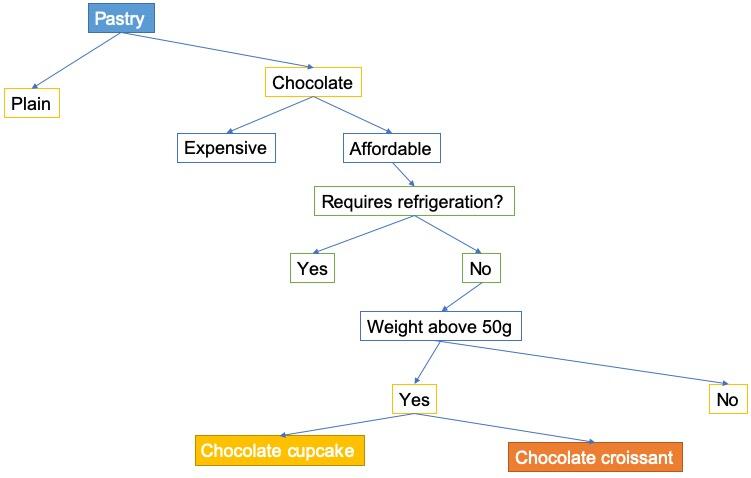Introduction
A decision tree represents a visual support tool targeted at helping its user to make a conclusion on the basis of available data. It is a tree-like graph that shows a consequence of decisions that are made with the help of information on outcomes, costs, and utilities. Each branch of a decision tree represents an outcome of a test, and each leaf node represents a step taken after computing the attributes (Anderson et al., 2016). Such a tool can be used in different contexts, both in professional and everyday life. The key aim of the user when developing a decision tree is finding a course of action when the majority of events are not controlled by the decision-maker. According to Topîrceanu and Grosseck (2017), decision trees have been successfully used in education in order to facilitate the learning and differentiate between the student archetypes and programs that would fit them.

The decision tree presented above shows the path of choosing a baked good at a local bakery. The decision between chocolate cupcakes and chocolate croissants is based on the attributes of flavor, price, refrigeration requirement, and weight. The two outcomes available to the decision-maker, in the end, all correspond to the characteristics of a baked good that is not plain but has an additional flavor, is affordable, does not require refrigeration, and weights more than 50 grams per item. The decision tree is an analytical way of making conclusions based on environmental factors of a subject of interest. It helps prioritize one decision after another using a predictive framework that simplifies the process choosing one option over another.
Summary
When creating the decision model, it was necessary to find some resources that would enhance the understanding of the subject. The study by Topîrceanu and Grosseck (2017) shows that decision trees can be used to align student profiles to their participation in online courses on the basis of their individual characteristics. Each unique branch of the tree developed by the scholars corresponded with the features of students’ profiles while the leaf nodes represented the profiles. The method was useful for aligning the needs of students with their learning needs and interests, thus making the educational process more productive and personalized.
References
Anderson, D. R., Sweeney, D. J., Williams, T. A., Camm, J. D., Cochran, J. L., Fry, M. J., & Ohlmann, J. W. (2016). Quantitative methods for business with Cengage NOW (13th ed.). Boston, MA: Cengage Learning.
Topîrceanu, A., & Grosseck, G. (2017). Decision tree learning used for the classification of student archetypes in online courses. Procedia Computer Science, 112, 51-60.